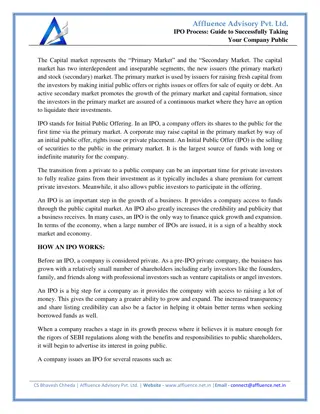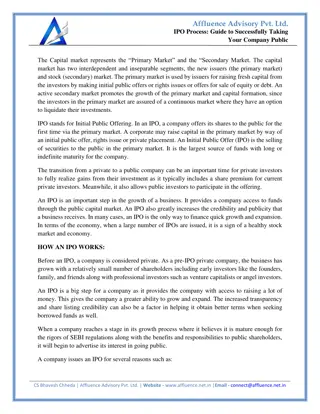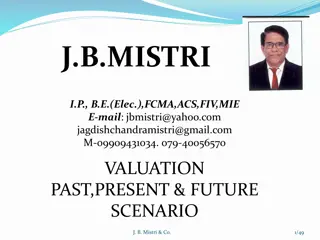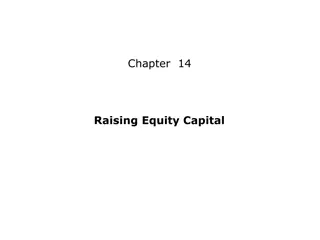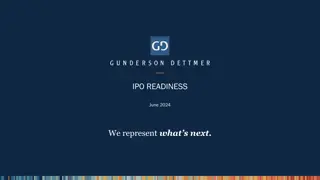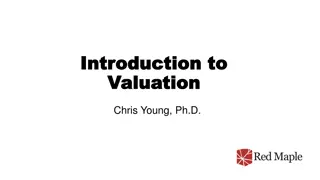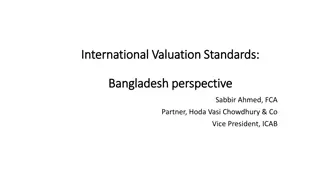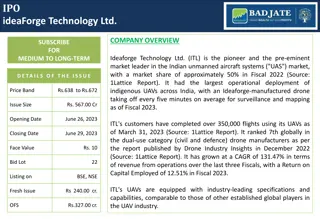Valuation Frameworks and Preparing for IPO in Indian Life Insurance Industry
Explore the differences between embedded valuation frameworks used by listed insurers in India versus internal frameworks, along with discussions on strategic decisions for IPO readiness, reasons for high valuations, and comparability issues. Dive into calculating Embedded Value and strategic considerations for maximizing company valuation for an IPO.
Download Presentation

Please find below an Image/Link to download the presentation.
The content on the website is provided AS IS for your information and personal use only. It may not be sold, licensed, or shared on other websites without obtaining consent from the author.If you encounter any issues during the download, it is possible that the publisher has removed the file from their server.
You are allowed to download the files provided on this website for personal or commercial use, subject to the condition that they are used lawfully. All files are the property of their respective owners.
The content on the website is provided AS IS for your information and personal use only. It may not be sold, licensed, or shared on other websites without obtaining consent from the author.
E N D
Presentation Transcript
36th India Fellowship Webinar Date: 22nd January 2022 IPO Process and Valuation of Life Insurance Companies Guide : P.K. Dinakar Presented By : 1. Rahul Somani 2. Mehul Patel 3. Siddarth Narayanan 4. Kritika Sharma
Introduction of Guide Dinakar is currently working with Hannover Re as Life Actuary. He has almost 30 years of total experience spanning across various companies within the life insurance industry. Dinakar started his career with LIC of India in 1990 and after a decade of service with LIC started working for different private life insurance companies. Dinakar holds a Master s degree in Statistics from Cochin University of Science & Technology. www.actuariesindia.org
Case Study You are an actuary responsible for shareholder reporting in an Indian life insurance company. You have been internally reporting value of new business (VNB) and embedded value (EV) of your company, developed on a traditional embedded valuation (TEV) framework. Your company has been selling predominantly participating and unit- linked insurance business in the past through mainly tied agency and bancassurance distribution channels. Given the high traded valuations (both in absolute terms and as a multiple of reported EV numbers) attracted by the listed life insurers in India, the promoters of your company are also aiming to launch an initial public offering (IPO) of your company. However, they have noticed that the valuation framework adopted internally is different from that required for the purpose of IPO. www.actuariesindia.org
Case Study Discuss the differences between the embedded valuation framework adopted by listed insurers in India vs. that adopted by your company. Also discuss the pros and cons of each of the approaches. Discuss the process involved in preparing your company for IPO, by referencing the various applicable regulations and actuarial practice standards. Discuss the strategic decisions you could take in the products / distribution channels in order to maximise the valuation at the time of IPO. Discuss the possible reasons for high traded valuations (as a multiple of EV) in Indian life insurance sector, as compared to other Asian / European markets. Discuss the issues involved in multiple of EV as a measure of comparability of valuations across insurers. Also discuss what could be the alternative measures used to compare valuations across insurers? www.actuariesindia.org
Embedded Value (EV) Embedded Value (EV) = Adjusted Net Worth (ANW) + Value of in-force covered business (VIF) where Adjusted Net Worth = Required Capital + Free Surplus EV reflects the value of business already written It does not allow for future new business We will look at the following 2 approaches of calculating EV- Traditional Embedded Value (TEV) Indian Embedded Value (IEV) www.actuariesindia.org
Embedded Value Components FC Cost of Capital Present Value of Future Profits Present Value of Future Profits TVFOG CRNHR VIF VIF Free Surplus Required Capital Free Surplus Required Capital TEV IEV ANW ANW where FC is Frictional Cost of Required Capital TVFOG is Time Value of Financial Options and Guarantees CRNHR is Cost of Residual Non-Hedgeable Risks www.actuariesindia.org
Comparison of Key Parameters Particulars Traditional Embedded Value Indian Embedded Value Adjusted Net Worth The assets could be valued at either book value (consistent with accounting practice and locked-in yields for investment return) or market value (with market yields). Investment returns are based on target asset mix and expected long-term returns on these assets. Allows credit for equity risk premiums. The assets are valued at market value. Investment Return Investment returns are based on risk-free returns. No credit for equity risk premium. www.actuariesindia.org
Comparison of Key Parameters Particulars Traditional Embedded Value Indian Embedded Value Allowance for Risk Implicit through the risk discount rate Explicit allowance through CRNHR Expense Assumptions No prescribed standard for expense assumptions Expense assumptions are based on current level of expenses with no allowance for future productivity improvements Cost of capital only reflects the frictional costs i.e. investment expense and taxes on investment income Cost of Capital Cost of capital allows for investment expenses, taxes and gap between investment return on solvency capital and risk discount rate www.actuariesindia.org
Comparison of Key Parameters Particulars Traditional Embedded Value Indian Embedded Value Cost of guarantees No prescribed standards for calculating cost of guarantees and no disclosure requirements Stochastic approaches prescribed for calculating cost of guarantees and explicit disclosure required Detailed disclosure requirements as per APS10 Disclosure Requirements No explicit disclosure requirements www.actuariesindia.org
Pros and Cons of TEV Pros Simplicity as it would be consistent with the current statutory reporting framework Cost of capital allows for the gap between investment return required and that which can be earned Higher discount rate than that which can be earned to allow for the risk is easier to explain to non-actuarial stakeholders Cons Greater subjectivity in the calculations due to absence of any standard Risk allowance is implicit in the risk discount rate and does not take into account the individual risks associated with the company No explicit disclosure requirements Difficult to compare the results of different companies as it would be impacted by underlying economic assumptions www.actuariesindia.org
Pros and Cons of IEV Pros Higher degree of comparability between results of different companies due to standard guidelines for methodology and assumptions Reduced subjectivity in the process of producing results, especially the investment return assumptions Risk quantification allows for the individual risks relevant to the company Materiality limits are specified under IEV Stochastic approach is required for TVFOG under IEV Standard format for analysis of movement Cons IEV could be volatile depending on movement in reference rates Reference rates may not be available for longer durations Models required for calculating IEV are more complicated www.actuariesindia.org
IPO related Regulations and APS IRDAI IRDAI (Issuance of Capital by Indian Insurance Companies Transacting Life Insurance Business) Regulations, 2015 Guidelines for Listed Indian Insurance Companies, 2016 Institute of Actuaries of India APS10 - Determination of the Embedded Value (EV) of life insurance companies incorporated in India and Regulated by IRDA for the purpose of Initial Public Offering (IPO). SEBI Securities and Exchange Board of India (Issue of Capital and Disclosure Requirements) Regulations, 2018. www.actuariesindia.org
Listing Process Appointment of merchant banker, lawyers, independent actuaries, data auditors Preparation of EV Report as per APS10 IRDAI Approval to IPO Filing of Draft Red Herring Prospectus with SEBI Approval from SEBI Marketing related to the IPO Filing the Red Herring Prospectus with Registrar of Companies Approval from stock exchanges IPO Pricing, Launch and Allocation of shares Listing on stock exchanges www.actuariesindia.org
Listing Process from Actuarys Perspective Change the EV and VNB calculation methodology to be consistent with APS10 Look at the revised EV and VNB margins along with the sensitivities to see if there is a requirement to make some strategic changes before the IPO Ensure that the company is compliant with all the requirements as per IRDAI regulations related to IPO Co-ordinate with the Independent Actuaries preparing the EV Report for IPO Co-ordinate with the Compliance Team for IRDAI Approval Provide the details related to IRDAI disclosure requirements or any SEBI requirements in the Red Herring Prospectus Provide the necessary actuarial advice for the company valuation for the IPO taking into account the various metrics such as EV, NB volume, VNB margin and the growth of these parameter over the recent years, solvency margin and strategic relations with Banks and other distribution channels. www.actuariesindia.org
APS 10 Requirements Embedded Value report under APS10 should be prepared and reviewed by Independent Actuaries. APS10 covers the following areas: Considerations affecting the appointment of an Actuary Data required for Valuation and checks on the same Valuation method Valuation assumptions Report and disclosures Working with other advisors Other considerations www.actuariesindia.org
APS 10 Disclosure Requirements APS10 prescribes the following minimum disclosures: Date of valuation Statement on the data used Statement on the management practices assumed Methodology adopted in valuation Assumptions adopted for the valuation Constituent parts of the components of economic value Analysis of movement of embedded value over last year (overall and each component) Sensitivity analysis on the embedded value and value of new business www.actuariesindia.org
IRDAI Regulations IRDAI (Issuance of Capital by Indian Insurance Companies Transacting Life Insurance Business) Regulations, 2015 Written approval from IRDAI required before approaching SEBI for IPO IRDAI approval is valid for one year within which the Insurer need to file Draft Red Herring Prospectus (DRHP) with SEBI The insurer also need to ensure compliance with Guidelines for Listed Indian Insurance Companies, 2016 www.actuariesindia.org
Considerations for IRDAI IRDAI considers the following general aspects while assessing IPO application: Company s overall financial position Regulatory Record The application for IPO The capital structure post IPO Purpose of the IPO www.actuariesindia.org
Considerations for IRDAI IRDAI also considers the following specific aspects while assessing IPO application: Period of business existence History of regulatory compliance Solvency margin over past six quarters Compliance with disclosure requirements Compliance with Corporate Governance Guidelines Compliance with the requirements of Indian owned and controlled Policyholder protection record Embedded Value Report as per APS10 www.actuariesindia.org
Disclosures required in Prospectus Risk factors specific to the Insurer Overview of the insurance industry Disclosure of Financial Statements Embedded Value Report Glossary of terms used in the insurance sector Particulars of the Issue Particulars about the Issuer Legal and Other Information www.actuariesindia.org
SEBI ICDR Regulations SEBI ICDR Regulations include the following for an IPO: Appointment of merchant banker and other intermediaries Filing of draft offer document with SEBI Draft offer document should be made public Filing the Prospectus with Registrar of Companies post changes specified by SEBI A copy of the final Prospectus should also be filed with SEBI Approval from stock exchanges is required where the shares will be listed post IPO Documents to be submitted before opening of the issue www.actuariesindia.org
Maximizing Valuation The company may choose to take a series of measures to maximize valuation at the time of the IPO. Primarily, we will focus on the following areas: Products Distribution Channels www.actuariesindia.org
Maximizing Valuation - Products Introduce Non Par business Profitability Volume Growth Diversified LOB mix Reduced cyclicality Par ULIP Non Par Savings Pure Protection VNB Margin* Low High *the graph only shows a generic trend and may change across products and companies www.actuariesindia.org
Maximizing Valuation - Addressing Key Risks Protection (Key risks: Mortality and Morbidity) Strong underwriting Customer segmentation Optimized reinsurance Non Par Savings (Key risk: Interest rate guarantees) Interest rate risk management (eg. FRA) Lapse management Optimize ticket size, PT and PPT sold Annuities (Key risk: Long term guarantees) Matching assets Agile repricing www.actuariesindia.org
Maximizing Valuation Product Management Maintain balanced LOB mix Risk management Natural diversification Competition strategy Innovation More attractive products and product features Identifying unaddressed customer needs in in the market www.actuariesindia.org
Maximizing Valuation Topline Growth Explore new channels Direct Sales (reduced external dependance, more control) Online (in-house and through partners, potential cost savings) CAB (reduced dependence on other channels, topline growth) Drive growth in existing channels (Banca, Tied Agency) Explore innovation & tie-ups tie-ups with fintech startups CC companies, telecom carriers scalable rural/group solutions www.actuariesindia.org
Maximizing Valuation - Efficiency and Quality of Channels Focused efforts to improve channel productivity Control agency retention and turnovers Link compensation to persistency Technological upgradation to aid efficiency Tight control of expenses Improve mortality and persistency reminders, repeated demonstration of value to customer ease of renewal premium collection targeted persistency efforts to improve value better underwriting to improve mortality experience www.actuariesindia.org
Maximizing Valuation - Channel management Similar to Products, maintain LOB flexibility reduced volatility in profits lower dependence on channel improving negotiation power reduces cyclicality/seasonality Long term sustainable sales practices selling as per needs zero tolerance to mis-selling trained sales force capable of guiding customers quick and convenient onboarding www.actuariesindia.org
Maximizing Valuation Other factors Improve brand trust and brand value transparent dealings adequate disclosures data protection advertisement Advanced business analytics and monitoring Tight expense overheads management Consistent performance and growth YoY www.actuariesindia.org
High traded Valuation of Indian Insurers Robust outlook for life insurance companies has found good support of investors High valuation is mainly driven by : Expectations of good premium growth potential Strong outlook for life insurers profitability Lower penetration and rising awareness of life insurance as a protection channel Rising traction for high profitable businesses 3.5 Traded Multiples for Life Insurers 3 3 2.5 2 1.7 1.4 1.5 EV Multiple 1.1 1 0.4 0.5 0 Source: Milliman 2020 Asia EV Report www.actuariesindia.org
Structural Growth Drivers in Place Favorable demographics ensure a long growth runway Combination of high share of working population, rapid urbanization, rising focus on financial inclusion to propel growth of Indian Life insurance sector Composition of Population Share of Urban Population 7% 8% 10% 40.10% 13% 34.90% 30.90% 31% 27.70% 34% 60+ years 37% 40% 30-59 years Share of Urban Population 28% 15-29 years 28% 26% 24% 0-14 years 35% 31% 27% 24% FY 2000 FY 2010 FY 2020 FY 2030 2000 2010 2020 2030 Source: International Monetary Fund Source: Swiss Re sigma No.3/2021 www.actuariesindia.org
Significant Under Penetration versus other Markets 25 Penetration Ratio as % of GDP Despite the high growth clocked by the sector, India remains an underpenetrated market India scores low in terms of insurance density, which is the absolute value of premium paid per capita Protection business is a structural story, in terms of improving penetration levels and profitability 19.2 20 15 Penetration Ratio as % of GDP 10 8.0 7.6 6.3 5.8 4.2 5 0 Source: Milliman 2020 Asia EV Report www.actuariesindia.org
Protection - the next growth driver MPG as % of Protection needed India has one of the highest protection deficits among other Asian countries Increase in disposable income coupled with pandemic-induced awareness of protection products will increase penetration level Closing the protection gap in India provides and opportunity of USD 78.2 Billion additional annual Premium till 2030 90% 83% 76% 80% 71% 70% 70% 60% 55% 50% 41% MPG as % of Protection needed 40% 30% 20% 10% 0% Source: Swiss Re sigma No.3/2021 www.actuariesindia.org
Financialisation of savings Higher share of young working population expected to be a tailwind In Low interest rate environment, traditional savings products are also evincing consumers interest Insurance industry offers variety of products as per the risk appetite Share of Insurance in Financial Savings 17% 17% 23% 24% 2% 7% 3% 8% 17% 23% 18% PF, Pensions and Claims of Govt Shares, Bonds & MFs Life Insurance Fund Currency and Deposits 17% 64% 55% 53% 51% Source: GNDI- Gross National Disposable Income FY 2014 FY 2016 FY 2018 FY 2020 www.actuariesindia.org
Emerging Opportunity in Retirement Solutions With the advancement of medical science, life expectancy has improved rapidly over the last few decades and demand for pension based products will increase with the rise in life expectancy Regulatory tailwinds like increase in commutation of pension corpus from 33.3% earlier to 60% will only benefit insurance sector Life Expectancy (years) 75.0 71.9 Life Expectancy (years) 67.6 2015 2035 2055 Source: UN World Population Report www.actuariesindia.org
Measures for comparability used in other industries like banking A. P/B Ratio = Market Price per share / Book value per share Book value is the tangible net asset value of a company or the carrying value on the balance sheet. P/B ratio is used by value investors to identify potential investments. B. P/E Ratio = Market Price per share / Earnings per share The P/E ratio is also known as the price multiple or the earnings multiple. P/E ratios are used by investors and analysts to determine the relative value of a company's shares. A high P/E ratio could mean that a company's stock is overvalued, or else that investors are expecting high growth rates in the future. www.actuariesindia.org
Why such measures do not apply for insurance industry? A. P/B Ratio = Market Price per share / Book value per share Book value reflects assets at amortized cost rather than market value Intangibles like goodwill have no value Book value does not reflect the margins in the policyholder liabilities B. P/E Ratio = Market Price per share / Earnings per share The reported earnings do not show a true picture due to: Upfront recognition of high acquisition cost Setting up reserves in the initial period Accrual of profits over the contractual maturity www.actuariesindia.org
Why multiple of EV is preferred measure for insurance industry? EV incorporates assets held at market consistent values Takes into account the margins in the policyholder liabilities EV includes present value of all future profits which results in allowance for long-term nature of insurance contracts and eliminates the distortion while considering one year s profits For listed insurers in India, EV is calculated using consistent methodology as per APS 10 enhancing comparability across insurers www.actuariesindia.org
Issues involved in multiple of EV Market Capitalization as a multiple of Embedded Value (X times) has the below limitations: EV does not account for value of future new business / structural value Actual financial performance over the past year is a small component of EV Sensitivity of EV to actuarial assumptions EV is a technical measure which is not well understood by masses Concept of EV is specific to insurance industry and cannot be used to measure performance with companies in other industries www.actuariesindia.org
Alternative measures to compare valuations across insurer EV does not account for value of future new business / structural value: A. Market Capitalization as a multiple of Appraisal Value (X times) Appraisal Value = Embedded Value (EV) + Value of future new business Appraisal Value is not a published value with prescribed guidelines for calculation introducing subjectivity B. (Market Capitalization less Embedded Value) as a multiple of Value of new business (X times) This intuitively indicates the number of years for which the insurer expects to add same value of new business as last year www.actuariesindia.org
Alternative measures to compare valuations across insurer Actual financial performance over the past year is a small component of EV: A. Return on Embedded Value (%) = Embedded Value Operating Profit / Opening Embedded Value Embedded Value Operating Profit (EVOP) includes expected return earned on opening EV, value added by new business, variance in operating parameters like mortality, persistency and expenses. It is not exposed to variation in economic variables. B. Market Capitalization as a multiple of EVOP (X times) This ratio for insurance intuitively can be thought of as a substitute to P/E ratio used in other industries. www.actuariesindia.org
Alternative measures to compare valuations across insurer Sensitivity of EV to actuarial assumptions: A. Market Capitalization as a multiple of Net Worth (X times) Net Worth = Paid up share capital +/- Fair Value change (Equity) +/- Accumulated balance of Profit and Loss account Net worth is a standardized value eliminating the sensitivity of EV to assumptions www.actuariesindia.org
Alternative measures to compare valuations across insurer EV is a technical measure which is not well understood by masses. Concept of EV is specific to insurance industry and cannot be used to measure performance with companies in other industries: Once the growth in the industry matures, other parameters used across industries like return on equity, return on capital employed, return on assets can be looked into for comparability across companies in other industries Operating profit margin and net profit margin are generally used as profitability indicators across companies in other industries. Once the industry matures and year-on-year earnings stabilize, P/E Ratio can be used to compare valuations across insurers and industries. www.actuariesindia.org
Thank You www.actuariesindia.org
Questions ? www.actuariesindia.org









